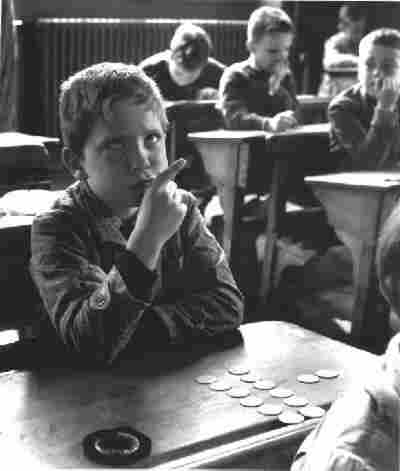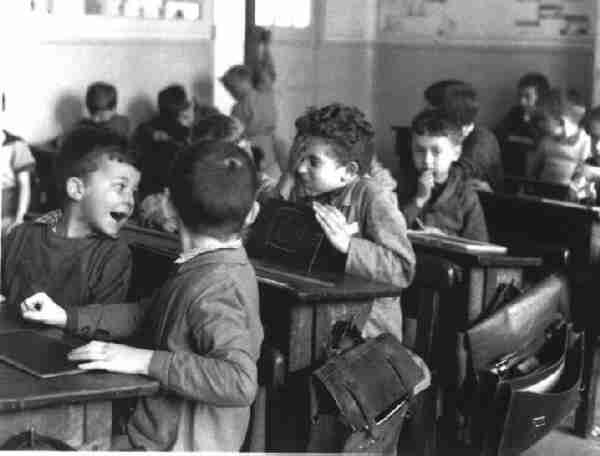
Figure 1.--.


Figure 1.--. |
French elementary boys through the 1950s wore smocks to school, almost always black, dark blue, or grey smocks. I am not sure what French schoolboys wore before the 1870s, but the school smock as we now know it was part of the educational reforms of the Third Republic. (The Third Republic was the Government that emerged in France after Louis Napoleon's (Napoleon III) defeat by the Prussians in the Franco-Prussian War in 1871. Educators thought that the smock was an ideal school garment. Not only did it protect clothes, but it hid differences in clothing resulting from social class. Thus boys and girls from affluent families could not show off with expensive clothes. (Sound familiar?) I'm not sure how the style was introduced, whether there was a national policy or if local schools had any disgression. Also I am not sure to what extent the Government spelled out the style of the smocks to be worn. It does look like most of the early smocks were black or dark blue and buttoned at the back. Available images confirm that French boys were wearing berets and smocks well before World War I--although I have no 19th Century images. The smock was generally worn with short pants and often a beret. The image of a boy going off to school in a beret, smock, and book satchel on his back is a nostalgic one for many French people.
I am not sure what French schoolboys wore before the 1870s, but the history of modern French school wear began in the 1870s with the social reforms of the Third Republic. The scool smock adopted then continued to be worn by French elementary school children until after World War II.
The school smock as we now know it was introduced as part of the educational reforms of the Third Republic. (The Third Republic was the Government that emerged in France after Louis Napoleon's (Napoleon III) defeat by the Prussians in the Franco-Prussian War in 1871. Educators thought that the smock was an ideal school garment. Not only did it protect clothes, but it hid differences in clothing resulting from social class. Thus boys and girls from affluent families could not show off with expensive clothes. (Sound familiar?) I know little else about the school clothes worn by elementary-age school children during this period, but believe kneepants were common, at least by the 1880s. I assume berets were widely worn, but I have few details.
French schoolboys continued to wear smaocks in the early 20th century. They were still very common and almost always worn with kneepants or short pants. Short pants increasingly replaced kneepants. Berets were also very common.
Schools smocks declined in popularity, but were still widely worn. Boys mostly wore them with them short pants and kneesocks. They were still commonly worn in the 1940s because many World War II images exists of French boys in smocks. They were not nearly as common as before World War I. Usage varied from school to school.
I believe that smocks were sill commonly worn in the 1950s, although by increasingly younger boys. Their use vasried substantially from school to school. A French contributor to this site tells me that he wore smocks as an elementary schoolboy during the late 1950s and early 60s, but did not wear a beret. Avaialble images show that in the 1940s and 50s, they were still common, but atbmany schools were only worn by a minority of the children. A few images show all the boys in smocks. Perhaps a few schools required them. While smocks were decling in the 1950s, French boys still commonly wore short pants. Smocks and shorts began to disappear in the late 1960s, especilly after the Paris student riots of 1968. Of course it was not the elementary children rioting, but actions of the older children soon filtered down to the younger children.
French schoolboys after the 1960s increasingly wore long pants. By the 1980s boys generally wore long pants to school. Many A,erican styles were adopted and the clothes worn by French boys were little different than the generic pan-Europdean style.
The image of a boy going off to school in a beret, smock, and book satchel on his back is a nostalgic one for many French people.

Figure 3.--French boys after World War II (1939-45) mostly wore casual colored shirts. |
French elementary boys through the 1950s wore smocks to school, almost always black, dark blue, or grey smocks. I'm not sure how the style was introduced, whether there was a national policy or if local schools had any disgression. Also I am not sure to what extent the Government spelled out the style of the smocks to be worn. It does look like most of the early smocks were black or dark blue and buttoned at the back. The smock was generally worn with short pants and often a beret.
Available images confirm that French boys were wearing berets and smocks well before World War I--although I have no 19th Century images.
I am not sure what kind of clothes boys wore under their smocks in the late 19th century. Images from the 1930s show that some boys were wearing suits to school. School dress appears to have been rather formal at svome elementary schools, at least by the older boys. I am not sure, but I think boys wearing suits to school would rarely wear a smock ovder it. Hopefully some pf our French contributors can confirm this. After World War II (1939-45), however, schoolwear became much more casual with boys almost never wearing suits to school.
I am not sure what kind of shirts French boys wore to school in the late 19th and 20th centuries. I do not believe white shorts and ties were common. By the late 1940s, boys were mostly weearing casual, colored shirts.
Sweaters were very commonly worn by French schoolboys. Heavt winter coats do not seem to be very common until the 1970s, but boys commonly wore sweaters.

Figure 4.--While not all French children wore smocks after World War II, they were very common at some schools. Note the book bags. |
I am not sure when kneepants became common, but ceratinly by the 1880s--probably earlirt. Kneepants began to be replaced with short pants. Almosy all French shools boys wore short pants un frm the 1920s-40s. Only in the 1950s did the begin to decline in popularity, at least duringbthe winter and for older boys. It was in the q950s that shorter cut short pants became stylish in France. Shorts began to become much less common in the 1970s. The new longer cut shorts began to appear in France furing the late 1980s.
French boys wearing kneepants generally wore three-quater-length socks. These were replaced with kneescks during the 1910s as short amtd became more common. Kneesocks declined in popularity during the 1940s, at least during the warm summer months.
French teachers are notorious for assigning extensive homework. Thus French children commonly trugged to school with heavy book bags.
Related Chronolgy Pages in the Boys' Historical Web Site
[Main Chronology Page]
[The 1880s]
[The 1930s]
[The 1940s]
[The 1950s]
[The 1960s]
[The 1970s]
[The 1980s]
Related Style Pages in the Boys' Historical Web Site
[Main French school type page]
[Main school uniform page]
[Main country page]
[Long pants suits]
[Short pants suits]
[Socks]
[Eton suits]
[Jacket and trousers]
[Blazer
[School sandals]
